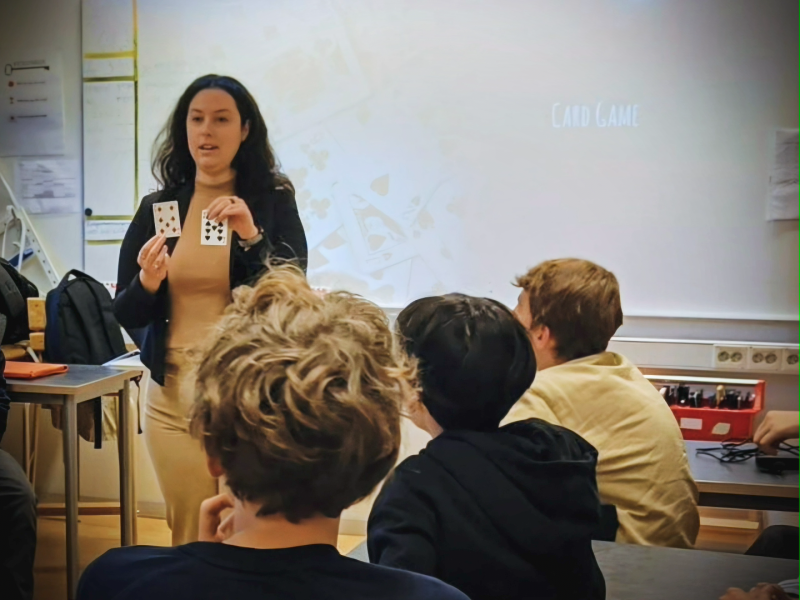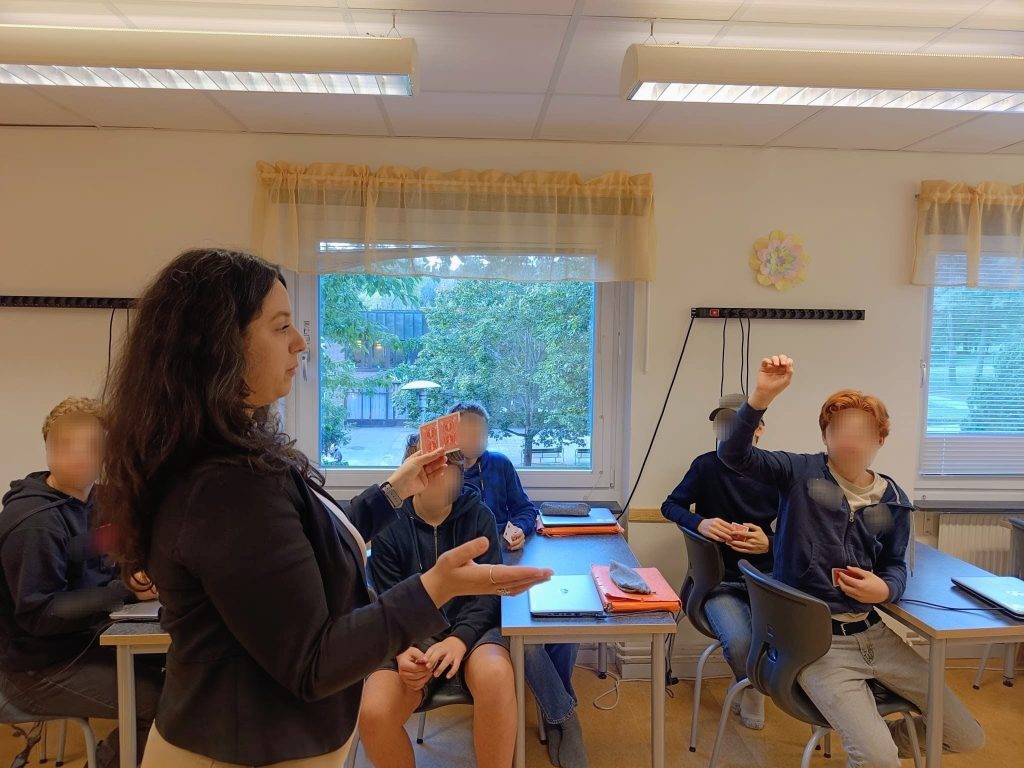
“Borrow a Researcher”: A Day of Discovery (for Them and Me!)
Have you ever wondered what it’s like to explain postdoc-level research to a classroom of high-energy teenagers? This month, I had the incredible opportunity to find out! I participated in ‘Borrow a Researcher’, a fantastic initiative designed to bring real-world, working research directly into the classroom.
I am a postdoctoral researcher at the Karolinska Institutet, trained as a biologist with a PhD in Biochemistry. Using bioinformatics, systems biology, and data analysis, I investigate the underpinnings of health and disease. Most of my career has been in the field of biological psychiatry, and now I am exploring mRNA translation patterns. If you are unsure about what half of that means, don’t worry, you are not alone. That’s exactly what Borrow A Researcher (Låna en forskare[1]) is for: translating complex science into tangible, accessible insights, and most importantly, inspiring a desire to know more.
Why I Signed Up?
I recognise that not every researcher feels comfortable or capable of this kind of public outreach, and that is completely understandable. This is also why I firmly believe that every scientist who is equipped to do so has a responsibility to engage in scientific communication. I genuinely enjoy the process, and based on feedback, I am somewhat effective at translating complex ideas into clear language. For me, this is not just a hobby — it’s a duty to ensure the public understands the research that shapes our world.
If I’m honest, this activity is a great tool for me too. It forces me to think outside the box, often sparking new ideas and insights simply through the process of trying to explain my work. Beyond that, I am a health scientist. My research is with and for the public. It has no value if it isn’t relevant and cannot be done without everyone’s support. Meaningful science requires a shared conversation.
Don’t get me wrong, I am an absolute fan of science for science’s sake. It gives me goosebumps when I think about serendipitous findings, about simply (or rather complexly) understanding how the universe works. That is how I got into science in the first place. I share the opinion that science and knowledge will always fundamentally benefit us. The truth is, only through deep understanding can we ask better questions. It reminds me of the classic example I heard a scientist from CERN once use when asked why so much money was invested in such fundamental research: when the phenomenon that eventually became radio waves was first discovered, it wasn’t called “radio” — it was merely an exotic, unnamed frequency band. That discovery was pure science, yet now, we rely on it every single second for communication, entertainment, and nearly every device we own. We take our phones and TVs completely for granted and can barely imagine a world without that initial piece of seemingly “useless” knowledge.
If you’re still not sold on why this kind of outreach is essential — and why every scientist should at least try it — consider this: It’s about the investment. Most research is made possible by public funds. That makes the taxpayers the chief stakeholders in our work. We owe them transparency. It is our duty to explain how their money is being used, how we are pushing the boundaries of knowledge, and how these efforts are designed to benefit our shared society down the line.
How it works: before the visit
I put up my name and research topic on the initiative’s website, together with suitable timeslots for a visit. I then received a booking request from Alia Sial, a teacher at Södertörns friskola. In the meantime, Vetenskap & Allmänhet also offered a very helpful training session with Anders Sahlman, who gave us valuable tips about how to prepare for the visits. Inspired by it, Alia and I set up a meeting to discuss the setting, students’ age range, and their knowledge level about the topics I study. I also asked her what could be more beneficial to talk about for the students. After this, I designed a presentation and activity outline, which I shared with Alia before my visit.
My activity outline went like this: a brief introduction about me and what it means to be a postdoctoral researcher (a.k.a. a full-time scientist that happens to have studied for many years, getting a PhD degree). Then we went directly into an interactive card game that helps the students experience the scientific method in a fun and relaxed environment. After learning they all had just been scientists for the last 10 minutes, I went on to tell them about my career journey, including why I got interested in science. I then explained in simple terms what biological psychiatry research is and why both genetics and environment shape our behaviour. I also spoke a little bit about my current research topic, what mRNA is and what happens before it turns into proteins. I let students ask away their questions throughout the whole activity.
How it went: the visit
To be honest, stepping onto school grounds for the first time in years was a moment of discomfort. Even more intimidating was the thought of talking to teenagers — I must admit, I was a little nervous! But I truly couldn’t have asked for a better environment to face that challenge. Right from the moment I arrived, I felt the familiar sense of being “hugged by nature” that I often find around Stockholm. The cool, fresh air and the lovely, tree-lined grounds of Södertörns friskola immediately melted the anxiety away.
I credit the smooth flow of the entire experience to Alia’s exceptional professionalism and support. She made me feel most welcome from the moment I arrived. As the session was conducted in English — since I’m still working on my Swedish — Alia was instrumental. She guided the students and asked precisely the right bridging questions to close any communication gaps, whether they were due to any concepts or the language itself, which kept the discussion focused and ensured every student could participate fully.
I heard questions like: Is it true for many behaviours that at some point in evolution they were adaptive? — That is an absolutely fantastic question. And to be honest, probably yes, to some extent (but that would be another whole post).
I even received a question that has genuinely stayed with me for days, forcing me to confront a linguistic absurdity: Why do we accept ‘protein’ as both a complex molecular structure essential to life AND a simple synonym for ‘meat’? That collision of biological terms and marketing jargon is so confusing — surely, we can do better!
Fun fact: The term protein was coined in 1838 by Swedish chemist Jöns Jacob Berzelius, who derived it from the Greek word πρώτειος (proteios), meaning primary — a nod to its fundamental role in sustaining life. Early nutritional science, however, was fundamentally shaped by a misleading but persistent notion: “flesh makes flesh.” Researchers had observed that animal muscle was highly concentrated with the vital macronutrient that Berzelius had named “protein,” leading to a strong and lasting association between meat consumption and the acquisition of this essential “body-building” nutrient; this legacy continues today, where “protein” often serves as a catch-all term for the main, often most expensive, and most nitrogen-dense element of a dish, whether it’s chicken, tofu, or fish. This original, misleading idea suggested that the protein we consume—especially from meat — was directly transformed into the protein in our bodies. In reality, the process is far more fascinating and complex: dietary proteins must first be broken down into their fundamental building blocks, amino acids, which are then absorbed and meticulously reassembled by our cells to form the specific proteins our bodies need. And here’s the best part: of the 20 amino acids essential for human biology, our bodies can synthesise most of them on their own — these are called non-essential amino acids. The remaining few, known as essential amino acids, must come from our diet — but not necessarily from meat. A well-balanced plant-based diet can provide all the essential amino acids, too! But I digress…
Anyways, the bottom line is I thought I was there to inspire them, but I left feeling energised and re-committed to my work. Their unfiltered curiosity was a powerful reminder of why my research matters in the first place.

Final thoughts
Somewhat a controversial opinion: I think we, as scientists, often overestimate our own communication skills while simultaneously underestimating the human capacity for understanding. We default to delivering easily consumable “truths” and reasons why people should or shouldn’t do something. This endless media loop of “should, should, should” — eat more veggies, take the vaccine — doesn’t empower anyone. I believe the human brain craves a greater challenge than simply receiving instructions! People become truly engaged when we offer them the fundamental questions and the tools to reach conclusions independently. Our role is much better fulfilled as guides, not holders of absolute truth. Isn’t that the whole point of science? We trust the answers not because someone told us they are true, but because the method consistently leads us there.
My greatest hope is that I didn’t just spread scientific knowledge that day, but that I instead managed to ignite a spark of curiosity, so they’ll continue to ask questions, challenge assumptions, and seek out answers for themselves. And perhaps most importantly, they’ll come to understand and trust the scientific method — not as a rigid set of rules, but as a powerful tool for making sense of the world.
Until we meet again,
Alana
[1] Borrow a Researcher (Låna en forskare) is a nationwide Swedish program managed by Vetenskap & Allmänhet (Public & Science Sweden). It offers an easy way for schools, non-profits, and workplaces across Sweden to schedule a researcher—either in-person or online—to discuss their work and career journey. Importantly, this initiative is a key part of ForskarFredag (Researchers’ Friday), which is Sweden’s version of the European Researchers’ Night. The program is funded by the European Commission via the Marie Skłodowska-Curie Actions, emphasising Europe’s collective effort to improve science communication, clarify research, and inspire the next generation of scientists.

0 comments